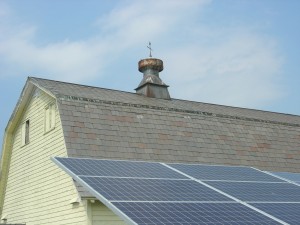for Clean Energy and Climate Action
The Vermont Legislature is exploring a couple of big energy bills that would redouble Vermont’s commitment to reducing fossil fuel consumption and help Vermonters transition to renewable resources.
One bill primarily targets the electric sector. There is also an effort afoot to tackle the state’s two largest greenhouse gas emitting sectors – heating and transportation – by putting a price on carbon pollution.
Here’s an update on, and brief overview of, these two big energy and climate-change-related proposals and their potential prospects under the Golden Dome.

Solar education site at the former CVPS location on Route 7, north of Rutland, Vermont. Photo: flickr/ IBEW Local 300
H.40 and S.51 – Establishing a Renewable Energy Standard and Energy Transformation Program
Both the House and Senate are considering bills that would replace Vermont’s SPEED program, which is set to expire in 2017, and enact a Renewable Energy Standard. The “RESET” program, as it is being called, will require utilities to meet a certain percentage of their electricity sales using renewable energy. For many, this is an essential transition away from Vermont’s current, controversial program, which has allowed utilities to sell the Renewable Energy Credits in the New England REC market (the trade-able, “green” attributes generated by solar, wind, etc. in Vermont) as well as count those projects toward Vermont’s own renewable energy goals.
-
This “Total Renewable Requirement” – 55% of sales in 2017, rising to 75% by 2032 – will eliminate any further double-counting by requiring the retirement of renewable credits. It will also help get more renewable energy built in Vermont and the region. Putting Vermont on par with the majority of the nation’s 50 states is only a piece of this proposal, though. The innovative element of the proposed legislation lies in the additional support given to small-scale renewables, energy efficiency and transportation innovation.
The second tier – “Distributed Generation”– mandates that utilities meet a percentage of their annual electricity sales – one percent in 2017, rising to 10% in 2032 – through community-scale (five MW or less) renewable projects, such as community solar or combined heat and power systems. The provision is aimed at continuing to spur small-scale renewable energy generation that communities often support and that benefits ratepayers through deferral or avoidance of transmission upgrades and reducing high-priced peak-power purchases.

Solar barn. Photo courtesy of Johanna Miller.
The third tier is the particularly innovative element. The “Energy Transformation” tier is a requirement that utilities support fossil fuel reduction solutions in the heating and transportation sectors – two percent of annual sales (in BTU equivalency) rising to 12% in 2032. This tier intends to foster new, creative projects and partnerships that reduce fossil fuel consumption. It aims to catalyze more comprehensive energy approaches, supporting investments in weatherization, cold-climate heat pumps, electric vehicle or ride-sharing solutions and far more.
Beyond the RESET legislation, which has strong support from the Public Service Department, utilities and advocates, there are also a couple of bills to push Vermont to tackle the state’s biggest greenhouse gas emitters – heating and transportation. The goal? Put a price on carbon pollution.
A growing coalition of business, academic, environmental and low-income advocacy groups – called Energy Independent Vermont – are working with lawmakers to explore Vermont enacting a carbon pollution tax.
Advocates, including Vermont Natural Resources Council, have undertaken a tremendous amount of research – including an independent economic analysis – to understand if such a policy would be good for Vermont. The conclusion: Vermont could enact a policy that 1) significantly reduces global-warming pollution, 2) does so in way that grows jobs and our economy and 3) mitigates the impact to low-income Vermonters.
The Energy Independent Vermont coalition’s plan is to return 100% of the proceeds from the tax back to Vermonters. A full 90 percent would go back in direct tax rebates or tax relief and 10 percent into an energy independence fund that Vermonters could tap to help them reduce their fossil fuel use and save money.
Here’s why it works: Vermonters now spend nearly $2 billion on fossil fuels each year, with nearly all of that money going directly out of Vermont and into the pockets of companies like Exxon Mobil. Putting a price on carbon pollution will keep millions more dollars in state thereby growing our economy, creating needed jobs and otherwise stimulating local economic activity. That will keep more money in Vermonters’ pockets to spend on groceries or going out to dinner – instead of on their heating bills.
The plan would also be implemented gradually, over 10 to 15 years, so Vermonters would have time to adjust and take advantage of the economic incentives the policy would create to reduce their heating and transportation costs.
A Vermont carbon pollution tax could be a big win for people’s pocketbooks, and the planet.
But it won’t be easy. A policy like this won’t be enacted overnight. It will take time to demonstrate how this policy will work, and how it will benefit all of us. The goal this session is to begin to shape the best policy, and move the ball forward.
For more information about Vermont’s campaign to enact a carbon pollution tax, or to get involved, visit energyindependentvt.org or contact VNRC’s Energy Program Director Johanna Miller at 802-223-2328 ext. 112 or jmiller@vnrc.org.








Leave a Reply